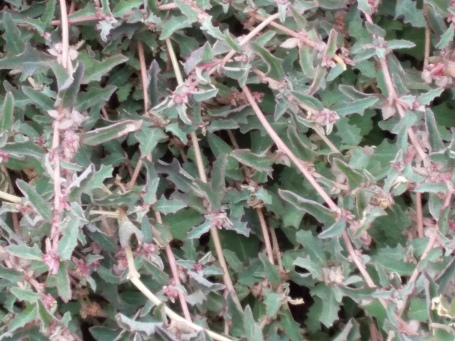Tags
At this time of year when it hasn’t rained properly for about 6 months and even the hardiest of our native trees and shrubs start to wilt, we say thank heavens for saltbush. This family of plants are the Australian climate change gardeners’ morale booster – the hotter and drier it gets the more they seem to leaf out, attract beneficial insects, tower in size over anything else and improve the conditions for other species.
The first species we have had success with, Old Man Saltbush (Atriplex nummularia), grows in inland areas of Australia. Its seeds were traditionally used as a food source for Aboriginal people, and the leaves are also edible and rich in protein, antioxidants, and minerals. It’s commonly used as a livestock grazing plant, which was one of the reasons we planted it, as a high-protein green fodder source at times of the year like this when there is not much else for stock to eat.

Old Man Saltbush is extremely drought and salt tolerant and apparently lives for more than 100 years! It accumulates salt in its leaves as it extracts water from the soil so can help to reduce salinity. It is very deep rooted and can access moisture and nutrients out of reach of other plants, making those nutrients available to other surface plants via grazing. Its roots travel up to 5m deep and 10m wide to access nutrients and moisture, as well as having surface roots to collect light rain and bind soil. It also sequesters carbon in the soil.
It is fast growing so can provide shelter within a few years to other plants or stock, and works well grown as a hedge/windbreak. I am keen to grow it as a hedge border around a vegetable garden in future as it attracts beneficial insects as well as blocking wind. It seems to grow fine on our heavy clays, though I note it prefers the dryer ridge to the more low lying winter waterlogged areas. And it has such nice grey-blue shimmery leaves! And kangaroos don’t seem to touch it! So much to love. It really is a hero of the plant world.

Woody trunk after 3 or 4 years growth
Another species we’ve been very grateful to be acquainted with is Creeping Saltbush (Atriplex semibaccata). We planted it on the disturbed slope next to our shed site as a way of stabilising the soil and avoiding erosion and it has thrived. It forms a dense low mat of up to 1.5m diameter, tolerates high levels of salinity and salt-laden winds, tolerates drought, has an edible berry, reduces soil temperature, and provides habitat for beneficial insects. On some of our hottest and driest summer days, it was green and covered in blue copper butterflies!

Creeping away
And it now seems to be coming up “by itself” (maybe with the help of ants moving fruit around) in a couple of other spots around our shed, not minding growing in gravel at all. This year we are planning to plant it on our gully walls in the hopes of stabilising those slopes, increasing habitat and creating a living mulch around other trees and shrubs.

Colonising the shed site
Finally, we are always overjoyed to see Ruby Saltbush (Enchylaena tomentosa) popping up by itself in various paddocks around the farm with no help from us (via birds or sheep perhaps). Again the small red fruits are edible, again it is ridiculously hardy tolerating drought, salt, and sand. Sheep love eating it, but unfortunately they leave nothing behind! And the green leaves are such a sight for sore eyes in this driest time of year.

We feel we have only just started on our journey experimenting with saltbush, and look forward to encouraging this family of perennial plants to be our allies on the path to increasing productivity and biodiversity.

Fabulous reading! Look forward to catching up when I come home 1 May for a few years at least.